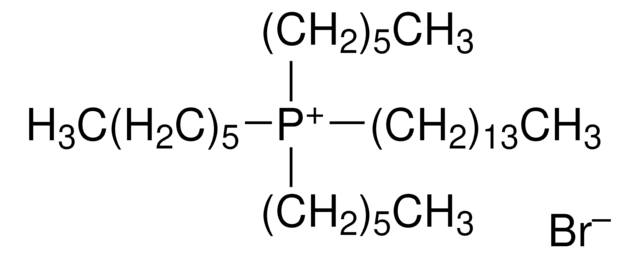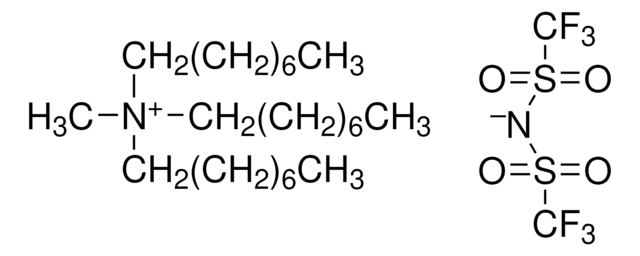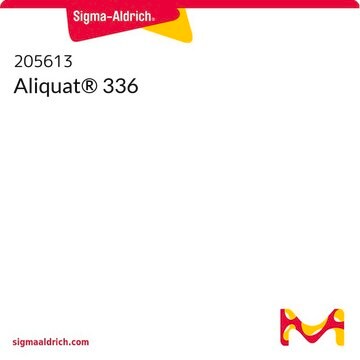50971
Trihexyltetradecylphosphonium bis(trifluoromethylsulfonyl)amide
≥95.0%
Sinónimos:
Tetradecyltrihexylphosphonium bis(trifluoromethylsulfonyl)amide
About This Item
Productos recomendados
Ensayo
≥95.0%
impurezas
≤1.0 water (Karl Fischer)
densidad
1.07 g/mL at 20 °C (lit.)
grupo funcional
fluoro
phosphine
cadena SMILES
FC(F)(F)S(=O)(=O)[N-]S(=O)(=O)C(F)(F)F.CCCCCCCCCCCCCC[P+](CCCCCC)(CCCCCC)CCCCCC
InChI
1S/C32H68P.C2F6NO4S2/c1-5-9-13-17-18-19-20-21-22-23-24-28-32-33(29-25-14-10-6-2,30-26-15-11-7-3)31-27-16-12-8-4;3-1(4,5)14(10,11)9-15(12,13)2(6,7)8/h5-32H2,1-4H3;/q+1;-1
Clave InChI
HYNYWFRJHNNLJA-UHFFFAOYSA-N
Descripción general
Aplicación
- The electrodeposition of nano and microcrystalline metals for electrochemical applications.[2][4]
- The synthesis of amino acid ionic liquid functionalized graphene (AAIL-GR) applicable as a biosensor.[1]
- The investigation of interactions between ionic liquids and fluorinated alkanes.[3]
- The synthesis of pure rutile and anatase phases of nanocrystalline TiO2.[5]
Otras notas
Palabra de señalización
Danger
Frases de peligro
Consejos de prudencia
Clasificaciones de peligro
Eye Dam. 1 - Flam. Liq. 3 - Skin Corr. 1B
Código de clase de almacenamiento
3 - Flammable liquids
Clase de riesgo para el agua (WGK)
WGK 3
Punto de inflamabilidad (°F)
125.6 °F
Punto de inflamabilidad (°C)
52 °C
Equipo de protección personal
Faceshields, Gloves, Goggles, type ABEK (EN14387) respirator filter
Elija entre una de las versiones más recientes:
¿Ya tiene este producto?
Encuentre la documentación para los productos que ha comprado recientemente en la Biblioteca de documentos.
Los clientes también vieron
Active Filters
Nuestro equipo de científicos tiene experiencia en todas las áreas de investigación: Ciencias de la vida, Ciencia de los materiales, Síntesis química, Cromatografía, Analítica y muchas otras.
Póngase en contacto con el Servicio técnico











